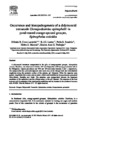Occurrence and histopathogenesis of a didymozoid trematode (Gonapodasmius epinepheli) in pond-reared orange-spotted grouper, Epinephelus coioides

Associated URL
scsagr.scsfri.ac.cnDate
2001Author
Page views
444Metadata
Show full item recordCited times in Scopus
Share
Abstract
A didymozoid trematode encapsulated in the gills of orange-spotted grouper, Epinephelus coioides Hamilton, was observed in October 1997 and September 1999 among pond-reared fish in the Philippines. Capsule prevalence was 33% and 18% and mean intensity 2 and 1, respectively. The opaque-white and yellowish capsules were found only on the first gill arch and were attached lengthwise along the posterior surface of the primary gill filaments. When the capsules were opened, long thread-like worms were revealed, which were identified as Gonapodasmius epinepheli Abdul-Salam, Sreelatha and Farah. The parasites were encapsulated between the basement membrane of the epithelium and the efferent artery of the gill filament. The response of the host included mild hyperplasia of the interlamellar epithelium and an increase in the number of mucous cells.
Suggested Citation
Cruz-Lacierda, E. R., Lester, R. J. G., Eusebio, P. S., Marcial, H. S., & Pedrajas, S. A. G. (2001). Occurrence and histopathogenesis of a didymozoid trematode (Gonapodasmius epinepheli) in pond-reared orange-spotted grouper, Epinephelus coioides. Aquaculture , 201(3-4), 211-217. https://doi.org/10.1016/S0044-8486(01)00668-8
Subject
Taxonomic term
Collections
- AQD Journal Articles [1240]


